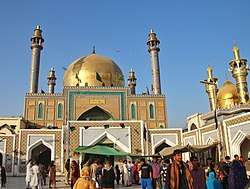Sehwan Sharif
Sehwan (Sindhi: سيوهڻ شريف, Urdu: سیہون; also commonly referred to as Sehwan Sharif or Noble Sehwan) is a historic city located in Jamshoro District of Sindh province in Pakistan and is situated on the west bank of the Indus 80 miles (130 km) north-west of Hyderabad. The city is renowned for being home of one of Pakistan's most important Sufi shrines, the Shrine of Lal Shahbaz Qalandar.
Sehwan سيوهڻ سیہون | |
|---|---|
 The Shrine of Lal Shahbaz Qalandar in Sehwan Sharif | |
 Sehwan | |
| Coordinates: 26.4193143°N 67.8593731°E | |
| Country | |
| Province | Sindh |
| District | Jamshoro |
| Population | |
| • Estimate () | over 100,000 |
| Time zone | UTC+5 (PST) |
| Calling code | 76140 |
Owing to the popularity of its Sufi shrine, the terms "Sehwan" and "Qalandar" are often used interchangeably in Pakistan. Sehwan is one of Pakistan's most important spiritual centres, along with other shrines such as the Shrine of Abdullah Shah Ghazi in Karachi, Data Durbar Complex in Lahore, Bari Imam in Noorpur Shehan near Islamabad, and the lustrous tombs of the Suhrawardi Sufis in Multan.[1]
History
Sehwan is probably the most ancient place in Sindh.[2][3] Some historians say that this town is as ancient as the period of Prophet Shees, son of Adam.[4] Hence it was named as Sheestan, Sewistan and then Sehwan.[4] According to Syed Muhibullah, author of "A brief history of Sind", Sehwan was the name of great grandson of Ham (son of Noah).[5] But there are various other views about the nomenclature of Sehwan as well. Notable historian Molai Sheedai writes in his book "Tarikh e Tamadan e Sind" that Sehwan was built by the Sewi Aryas and hence was called Sewistan. Another view is that its name was Sindomana, a name which is well mentioned in Greek literature.[4] Sindhu-mán is Sanskrit word, which means "the possessor (the capital, or Raja) of Sindh, with which Sindhu-vàn is synonymous, the latter may have been softened in common speech to the modern Seh-wan.[6] Sindomana was the capital of King Sambos, who was defeated by Alexander in 326 BC.[7]
Sehwan was conquered by Muhammad bin Qasim in 711 from son of the King Dahir, and three centuries later by Mahmud of Ghazni in 1026. In all the subsequent dynastic struggles of Sindh, Sehwan continued to feature prominently. It was held successively by the Sumrahs, the Summas, the Arghuns and the Tarkhans.[8] It was the capital of Thatta Kingdom,[9] when an abortive attempt was made by the Mughal emperor Humayun to capture it on his way to Umarkot in 1542,[10] but it finally fell to his son Akbar in 1590s.[11] After the moghuls, it was ruled by Kalhoras and Talpurs.[8]

The city is known for its Sufi patron saint Lal Shahbaz Qalandar who lived there in the 13th century.
The Shrine of Lal Shahbaz Qalandar attracts hundreds of thousands of visitors every year. Shrine of the Sufi saint Murshid Nadir Ali Shah, a notable spiritual successor of Lal Shahbaz Qalandar is also located in Sehwan,[12] where large number of people are served free meals round the clock.[13][14] Another famous place is the inverted city.[15] Manchar Lake, the largest freshwater lake in Pakistan, which is at a short distance from Sehwan Sharif.[16]
Incident
On the 16th of February 2017, a suicide bomber triggered an explosion at the Shrine of Lal Shahbaz Qalandar, killing at least 83 people and injuring almost 250. The attack occurred during a praying session. The bombing took place at an 800 year old Shrine.[17][18] Later the ISIS claimed responsibility for this terrorist attack stating that their 'martyr' had detonated a vest at the popular Shia gathering at the shrine.[19]
References
- Akhtar, Suleman (22 February 2017). "Damadam mast Qalandar is a cry of rebellion against established orders". Dawn. Retrieved 22 February 2017.
- Bradford, Alexander Warfield (1843). Antiquities and Researches Into the Origin and History of the Red Race. Newyork: Wiley & Putnam. p. 425.
- Caine, William Sproston (1891). Picturesque India:A Handbook for European Travellers. London: George Routledge and Sons Limited. p. 192.
- Pakistan Library Bulletin Volume 18. Pakistan: Library Promotion Bureau. 1987. p. 42.
- Ali, Ansari Ali Sher (1901). A Short Sketch, Historical and Traditional, of the Musalman Races Found in Sind, Baluchistan and Afghanistan, Their Genealogical Sub-divisions and Septs, Together with an Ethnological and Ethnographical Account. Karachi: Commissioner's Press. p. 64.
- Wilson, Horace Hayman (1841). Ariana Antiqua:A Descriptive Account of the Antiquities and Coins of Afghanistan. London: East India Company. p. 205.
- Gazetteer of the Province of Sind. India: Government at the "Mercantile" Steam Press. 1907. p. 522.
- The Modern Review, Volume 81. India: Prabasi Press Private Limited. 1947. p. 122.
- John F. Richards, The New Cambridge History of India: The Mughal Empire (New York: Cambridge University Press, 19930 p. 51
- The History and Culture of the Indian People: The Mughal empire. India: G. Allen & Unwin. 1974. p. 57.
- Richards, John F. (1995). The Mughal Empire. Cambridge University Press. p. 51.
- Donkin, William (2001). The Wayfarers: Meher Baba with the God-Intoxicated. Myrtle Beach, S.C.: Sheriar Foundation. ISBN 1-880619-24-5.
- Khushik, Qurban Ali (2007-09-01). "Call of Qalandar". DAWN.COM. Retrieved 2019-03-15.
- Correspondent, The Newspaper's (2014-06-18). "Qalandar Urs celebrations get under way". DAWN.COM. Retrieved 2018-02-04.
- Soomro, Farooq (2014-10-10). "Sehwan: The undisputed throne of Lal Shahbaz Qalandar". DAWN.COM. Retrieved 2018-02-23.
- "Lake Manchar – A Perfect Holiday Destination". Sindhi Dunya. 2015-09-14. Retrieved 2018-02-23.
- Ray Sanchez, Sophia Saifi and Adeel Raja. "At least 75 killed in suicide attack at Pakistani shrine". CNN. Retrieved 2017-02-21.
- "Blast hits Pakistan's Lal Shahbaz Qalandar Sufi shrine". www.aljazeera.com.
- "Isis claims responsibility for suicide bombing at Muslim shrine". The Independent. 2017-02-16. Retrieved 2019-09-03.
External links
| Wikivoyage has a travel guide for Sehwan. |